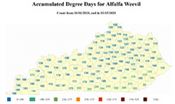Begin Scouting Fields For Alfalfa Weevil
DR. RIC BESSIN
PRINCETON, KY.
The UK Ag Weather Center’s degree day model for alfalfa weevil indicates that some counties in southern Kentucky have exceeded the 190DD used as a starting point to begin scouting. Other counties will exceed that total within the next few days. Growers are advised to scout fields and begin their alfalfa weevil larval counts.
Following the relatively mild winter, there will likely be more hatching of winter-laid alfalfa weevil eggs this year. These eggs hatch earlier than the spring laid eggs. The 190 DD target estimates when the first leaf feeding damage becomes noticeable from these early larvae.
Damage by the young larvae will first appear as tiny pin holes in the leaves.
Scouting
To scout for alfalfa weevil, use the stem sampling method. While walking in a “U” or “Z” pattern through a field, collect 30 alfalfa stems. Carefully cup the top of each stem in one hand and break it off the crown with your other hand; place it bud-end downward in a plastic bucket. Be sure samples are at least 20 feet from the edge of a field so that they are representative of the entire interior of a field. Knock groups of 4 or 5 stems at a time against the inside of the bucket to dislodge the larvae. Count the number of larvae. Measure the length of 10 random alfalfa stems. Use the economic threshold tables in ENTFACT 127 or ENT-17 to determine the need to spray the field for alfalfa weevil. If the field is close to harvest, harvest can be an alternative to spraying, but producers need to watch for damage to the regrowth; there are similar scouting tables for regrowth after the first cutting. ∆
DR. RIC BESSIN: Extension Entomologist, University of Kentucky

Figure 1. When degree day totals reach 190 Degree Days, it is time to begin scouting for alfalfa weevil
larvae. Scouting continues until regrowth after the first cutting.